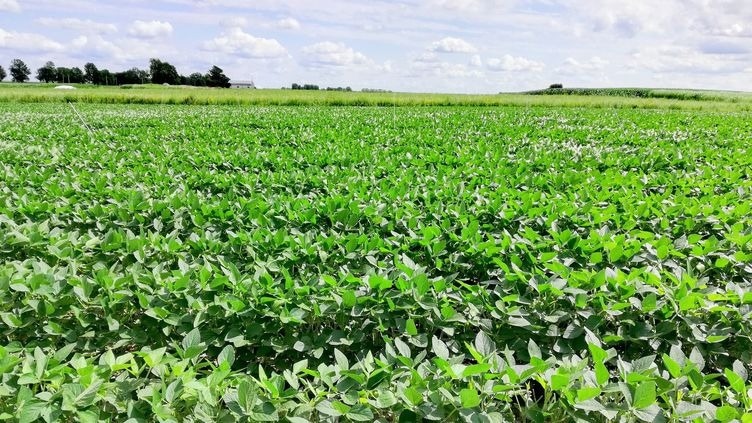A research team from the University of Sheffield’s Leverhulme Centre for Climate Change Mitigation used a cutting-edge earth system model to simulate the effects of reducing N2O emissions, using fertilizers with nitrification inhibitors and enhanced rock weathering, across two different climate scenarios, both of which followed international agreements to protect the ozone layer. Their findings were published in the Nature Journal npj Climate and Atmospheric Science.
 Enhanced weathering test fields of soybean at the Energy Farm, University of Illinois, Urbana- Champaign. Image Credit: N. Leisgang, Harvard University, formerly Department of Physics, University of Basel/Scixel
Enhanced weathering test fields of soybean at the Energy Farm, University of Illinois, Urbana- Champaign. Image Credit: N. Leisgang, Harvard University, formerly Department of Physics, University of Basel/Scixel
According to recent study findings, farming practices can lower nitrous oxide emissions without impeding the ozone layer's overall recovery.
The amount of nitrous oxide (N2O), a strong greenhouse gas 300 times more potent than CO2, is increasing alarmingly in the atmosphere. Significantly, agriculture increases N2O emissions.
According to a recent study from the University of Sheffield, agricultural N2O emissions could be decreased without depleting the ozone (O3) layer by utilizing certain fertilizers and broken basalt rocks, a process known as improved rock weathering.
The development of N2O reduction measures to prevent soil from releasing nitrous oxide into the atmosphere is a global priority. However, there have been worries that reducing these emissions might impede the ozone layer's recovery.
Using a cutting-edge earth system model, the research team from the Leverhulme Centre for Climate Change Mitigation at the University of Sheffield simulated the effects of reducing N2O emissions in two distinct climate scenarios—both of which followed international agreements to protect the ozone layer—by using fertilizers with nitrification inhibitors and enhanced rock weathering.
The model made it possible for the study to account for the effects of future temperature conditions and other significant chemicals on the atmosphere, such as CFCs. The amount that the Earth's temperature would rise under each scenario varied. The analysis's consideration of N2O reductions constituted a workable planned strategy and illustrated how this reduction strategy would affect the ozone layer in many future scenarios.
The study, which is unique in that it bridges the gap between mitigating climate change and protecting the ozone layer, highlights the twofold benefits of N2O reduction strategies. These benefits include protecting the O3 layer, which shields the planet from harmful UV rays, and reducing nitrate leaching into water bodies and natural habitats. Developing comprehensive environmental policy requires this synergy.
Dr. James Weber, a former postdoctoral researcher at the University of Sheffield, carried out the research under the direction of Drs. Maria Val Martin and David Beerling from the School of Biosciences and the Leverhulme Centre for Climate Change Mitigation.
The results showed that a feasible use of fertilisers with nitrification inhibitors and enhanced rock weathering could cut agricultural N2O emissions by about 25 per cent without hindering ozone recovery. This supports the alignment of agricultural practices with international climate and ozone protection policies, such as the Montreal Protocol and we hope this will influence policymakers to integrate N2O mitigation measures more robustly into climate action plans and potentially lead to new regulations and incentives for farmers to adopt these practices.
Dr Val Martin, Study Co-Author and UKRI Future Leaders Fellow, University of Sheffield
Improved weathering techniques for reducing N2O have cost-free co-benefits, according to the study's economic analysis.
The findings emphasize the importance of N2O mitigation for sustainable agriculture, aligning with efforts to reach net-zero emissions while still supporting increased food production for a growing population. The study has highlighted cost-effective methods for reducing N2O emissions, such as enhanced weathering of agricultural soils with crushed basalt. These practices offer financial savings for farmers and can reduce the overall cost of achieving climate goals, benefiting taxpayers and consumers.
David J Beerling, Study Co-Author and Director, Leverhulme Centre for Climate Change Mitigation
All things considered, the study demonstrates that lowering farm N2O emissions is a secure and practical strategy to combat climate change and save the ozone layer. It is believed that this would result in new farming methods that benefit both the environment and human health.